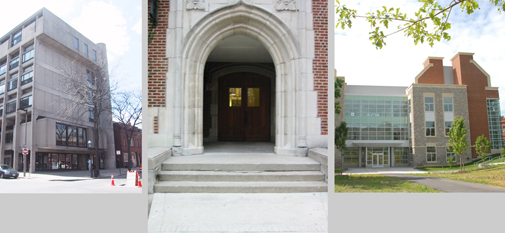There are over 3,000 Carnegie halls in the United States — many were designed as libraries or science buildings and many are on college and university campuses. Over time, as institutional needs and
programs change, the buildings have changed, but the name
remains the same.
At Pomona College, Carnegie Hall is now a humanities and social science building. At Juniata College, Carnegie Library is now a
museum and arts building. Allegheny College’s Carnegie Hall of Chemistry is now a humanities and social science office and classroom building. And at St. Lawrence University, Carnegie Hall of
Science is now home to languages and international programs. What’s in a name?
At Carleton College, the Sayles-Hill Gym has been transformed into a student center, and at Wittenberg, Koch Chemistry is now an arts building. What’s in a name?
So the name stays the same and functions change. Why would a college or university change its name?
Changing names goes back in time to the original colonial colleges. Of the nine colonial colleges, five have changed their names for a number of reasons — political, donor recognition, and location. The College of New Jersey became Princeton when it relocated the campus from Elizabeth to Princeton, NJ. Kings College became
Columbia after an 8 year lacuna of instruction during the Revolutionary War. The College of Philadelphia became the University of
Pennsylvania through a more complex series of moves — mostly
political. The College was split into two institutions when the State created the University of the State of Pennsylvania. The two were reunited under their present name in 1791. The College of Rhode Island became Brown University when the campus relocated from Warren, RI to Providence and took on the name of a significant
donor. Queens College was chartered in 1766 and became Rutgers University in 1825 in honor of the philanthropist Colonel Henry Rutgers.
Usually an institutional name change follows changes in curriculum and program offerings. The typical change is from college to
university. Loyola College became Loyola University of Maryland.
Marketing is another reason to change the name. The Boston
Architectural Center was an accredited, degree granting institution since the early 1970s — but was largely unknown outside the
architectural professional world. The Boston Architectural Club, became the Boston Architectural Center, and just recently became the Boston Architectural College — reflecting what it actually was: an independent, accredited college offering both Bachelor of
Architecture (B.Arch), and Master of Architecture (M.Arch) degrees.

Sometimes a change in mission requires a change in name. Florida Junior College at Jacksonville became Florida Community College at Jacksonville in 1986. Recently, it became Florida State University and has expanded their programs and degree offerings and
currently serves over 80,000 students on four campuses.
Sometimes, names are changed to avoid confusion. Northface University has changed its name to Neumont University in order to eliminate any confusion with the clothing manufacturer.
Other changes have to do with geography — especially in California where the tradition is to name the campus for the city in which it is located. The California State University, Fullerton El Toro is now CSUF Irvine.
In 1994, Arkansas College became Lyon College to honor a family that was a major supporter of the institution — and to commemorate a significant gift.
The jokes were annoying yet tolerable — although often crude — but their college name became a real problem when internet porn filters stopped campus emails and access to their website. The 150 year old independent women’s college in Philadelphia changed their name from Beaver College to Arcadia College.

…… and now it is time for us to change our name. It is time to
recognize the people who actually have been actively and
personally involved with all of our college and university planning and programming projects for the past several decades:
DOBER LIDSKY MATHEY.
“What’s in a name? That which we call a rose
By any other name would smell as sweet.”
- Romeo and Juliet

Arthur Lidsky



